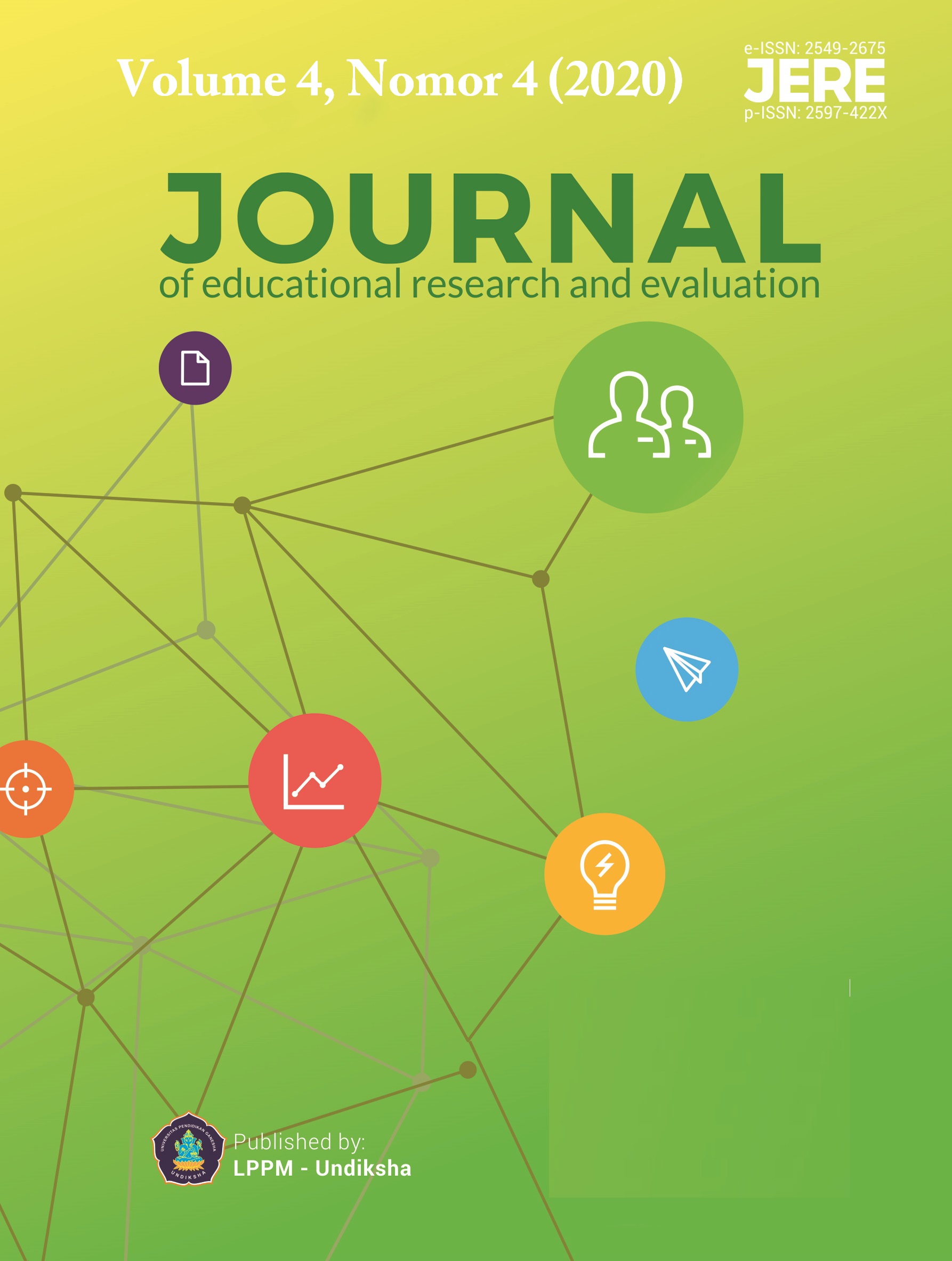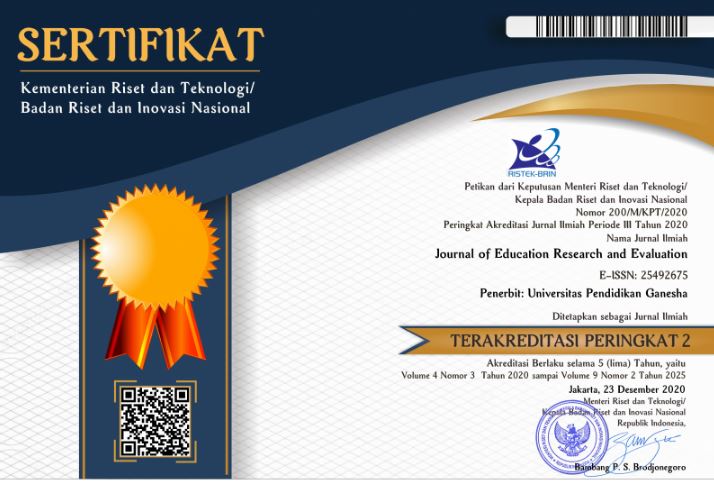Classroom Communication in Early Childhood Education
DOI:
https://doi.org/10.23887/jere.v4i3.27097Abstract
This study aims to investigated the speech act types and communication strategies in early childhood education. This research was a classroom research. Data were collected through unobtrusive observation during learning interactions. The obtained data were analyzed qualitatively. The recorded children’s and teachers’ speech acts were totaled 360. The research findings are as follows. Firstly, the recorded speech consisted of four types, they are: directive, expressive, declarative, and assertive acts. Directive acts were the most frequently used (93.3%), followed by expressive acts (5%), assertive acts (1.4%), and declarative acts (0.3%). The telling speech acts dominated the verbal interactions (44.4%) followed by request speech acts (32.2%). Secondly, 360 communication strategies were found. The telling and request sub-speech acts were delivered using compensatory strategies (96.11%). The teachers used 280 code-switching strategies (77.78%) while the children used none (0%); 14 non-linguistic forms strategies (3.89%) were used by the teachers while 6 self-repairs strategies (1.67%) by the children; 14 all-purpose words strategies (3.89%) were used by the teachers while none (0%) by the children; 14 asking for repetitions strategies (3.89%) were used by the teachers while none (0%) by the children; none filters/hesitation devices strategy (0%) was used by the teachers while 8 (2.22%) by the children; none (0%) literal translation strategy was used by the teachers while 12 (3.33%) by the children. The most frequently directive acts imply towards the effectiveness of the children’s communicative skill.
References
Al-Gharaibeh, S., & Al-Jamal, D. A. (2016). Communication Strategies for Teachers and their Student in an EFL Setting. International Journal of Bilingual & Multilingual Teachers of English, 4(1), 33-44. http://www.researchgate.net/publication/306323804_Communication_Strategies_for_Teachers_and_their_Students_in_an_EFL_Setting.
Austin, J. L. (1962). How To Do Things With Words. London: Oxford University Press.
Azarnoosh, M. (2014). Communicating in a Second Language : A Matter of Teaching Communication Strategies.
Basra, S. M., &Thoyyibah, L. (2017). A SPEECH ACT ANALYSIS OF TEACHER TALK IN AN EFL CLASSROOM. International Journal of Education, 10(1), 73. https://doi.org/10.17509/ije.v10i1.6848
Bayat, N. (2013). A study on the use of speech acts. Procedia - Social and Behavioral Sciences, 70, 213–221. Retrivied from: https://doi.org/10.1016/j.sbspro.2013.01.057 on january 29th, 2020.
Bijani, H., & Sedaghat, A. (2016). The application of Communication Strategies by Students with Different Levels of Communication Apprehension in EFL Context. Theory and Practice in Language Studies, 6(2), 366-371. http://www.academypublication.com/ojs/index.php/tpls/article/download/tpls0602366371/602.
Brown, H. D. (2007). Principles of Language Learning and Teaching (5th ed.). White Plains, NY: Pearson Education.
Corder, S. (1983). Strategies of Communication. In C. Faerch and G. Kasper, (Eds.) Strategies in Interlanguage Communication. London: Longman, 15-19.
Dörnyei, Z & Scott, M. (1997). Communication Strategies in a Second Language Definitions and Taxonomies. Language Learning, 47(1), 173-209. https://doi.org/10.1111/0023-8333.51997005
Fatima Sultan Shaikh. "Effective Methods of Teaching English as a Second Language in the Classroom", International Journal of Science and Research (IJSR), https://www.ijsr.net/search_index_results_paperid.php?id=SUB151296, Volume 4 Issue 2, February 2015, 979 - 984
Faerch, C. & Kasper, G. (1983). Plans and strategies in foreign language communication. In C. Faerch and G. Kasper (Eds.), Strategies in interlanguage communication (pp. 20-60). London: Longman.
Gooden, C. & Kearrns, J. (2013). The Importance of Communication Skills in Young Children. Human Development Institue. Unversity of Kentucky.
Hunter, T., & Walsh, G. (2013). From policy to practice?: the reality of play in primary school classes in Northern Ireland. International Journal of Early Years Education, 22(1), 19–36. doi:10.1080/09669760.2013.830561
JarmilaBubikova-Moan, Hanne NæssHjetland & Sabine Wollscheid (2019) ECE teachers’ views on play-based learning: a systematic review, European Early Childhood Education Research Journal, 27:6, 776-800, DOI: 10.1080/1350293X.2019.1678717
Jonsson, A. & Williams, P. (2013). Communication with young children in preschool: the complex matter of a child perspective, Early Child Development and Care, 183:5, 589-604, DOI: 10.1080/03004430.2012.678488
Mariani, L., Communication strategies: Learning and teaching how to mangage oral interaction, NA: Learning Path-Tante Vie Per Imparare, 2010.
Martínez-Adrián, M., Gallardo-del-Puerto, F., & Basterrechea, M. (2017). On self-reported use of communication strategies by CLIL learners in primary education. Language Teaching Research, 136216881772205. doi:10.1177/1362168817722054
Merdana, Seken, K., & Putra, N. A. (2013). An Analysis of Speech Acts Produced by Elementary School Teachers and Students to Facilitate Teaching and Learning at SDN 10 Peringgasela East Lombok. e-Journal Program Pascasarjana Universitas Pendidikan Ganesha. https://www.neliti.com/id/publications/118108/an-analysis-of-speech-acts-pruduced-by-elementary-schoo;-teachers-and-students-t.
Mujiono, Poedjosoedarmo, S., Subroto, E., & Wiratno, T. (2013). Code-switching in English as Foreign Language Instruction Practiced by English Lecturers at Universities. International Journal of Linguistics, 5(2), 46-64. Retrieved from: http://www/macrothink.org/journal/index.php/ijl/article/download/3561/pdf on December 12th, 2019.
Nakatani, Y. (2010). Identifying Strategies that Facilitate EFL Learners' Oral Communication: A Classroom Study Using Multiple Data Collection Procedures. The Modern Language Journal, 94, 116-136. https://onlnelibrary.wiley.com/doi/full/10.1111/j.1540-4781.2009.00987.x.
Nassaji, H. (2015). Qualitative and Descriptive Research: Data Type Versus Data Analysis. Language Teaching Research, 19(2) 129-132. DOI: 10.177/13626885572747
Norrick, N. R. (1978). Expressive Illucotionary acts. Journal of Pragmatics, 277-291. Retrieved December 15, 2013, from https://www.scienticedirect.com/science/artcle/abs/pii/037821667890005X
Nurani, N. P. (2015). A pragmatic analysis of classroom speech acts in the English teaching and learning process at SMA N 1 Purworejo (A Case Study). (Unpublished Thesis). Yogyakarta State University, Indonesia.
Oktaviani, A., & Misgiyati, D. (2018). Communication Strategies Used by the Primary Teachers in EFL Classroom. Linguistic, English Education and Art (LEEA) Journal, 2(1), 1-18. https://doi.org/https://doi.org/10.31539/leea.v2i1.386.
Palupi, M. D. (2008). Communication Strategies Used by EFL Young Learners of Sixth Graders Elementary School At Cita Hati Surabaya. Unpublished thesis. Surabaya: Petra Chirstian University.
Ryckebusch, C., & Marcos, H. (2004). Speech acts, social context and parent-toddler play between the ages of 1;5 and 2;3. Journal of Pragmatics, 36(5), 883–897. doi:10.1016/j.pragma.2003.10.019
Searle, J. R. (1979). Expression and Meaning: Studies in the Theory of Speech Acts. Cambridge: Cambridge University Press.
Suarini1, N. W., Seken, I. K., & Padmadewi, N. N. (2019). The Use of Communication Strategies by The Teacher as aTechnique of Teaching to Help Students Learn to Communicate in English on Elementary Level in Bali Children Foundation. Jurnal Pendidikan Bahasa Inggris Undiksh. 7(1), 48-58. http://dx.doi.org/10.23887/jpbi.v7i1.20607
Syahrial, A. (2013). Types of Communication Strategies Used by Young Learners in Bethany School Salatiga. The 7th International Seminar. http://ris.uksw.edu/download/makalah/kode/M01188.
Trosborg, A. (1995). Interlanguage Pragmatics: Request, Complaints, and Apologies. Berlin: Mouton de Gruyter.
Velentzas, J. O. H. N. & Broni, G. (2014). Communication cycle: Definition, process, models and examples. Recent advances in financial planning and product development, 117-131.
Downloads
Published
How to Cite
Issue
Section
License
Authors who publish with the Journal of Evaluation and Research in Education (JERE) agree to the following terms:
- Authors retain copyright and grant the journal the right of first publication with the work simultaneously licensed under a Creative Commons Attribution License (CC BY-SA 4.0) that allows others to share the work with an acknowledgment of the work's authorship and initial publication in this journal.
- Authors are able to enter into separate, additional contractual arrangements for the non-exclusive distribution of the journal's published version of the work (e.g., post it to an institutional repository or publish it in a book), with an acknowledgment of its initial publication in this journal.
- Authors are permitted and encouraged to post their work online (e.g., in institutional repositories or on their website) prior to and during the submission process, as it can lead to productive exchanges, as well as earlier and greater citation of published work. (See The Effect of Open Access)











